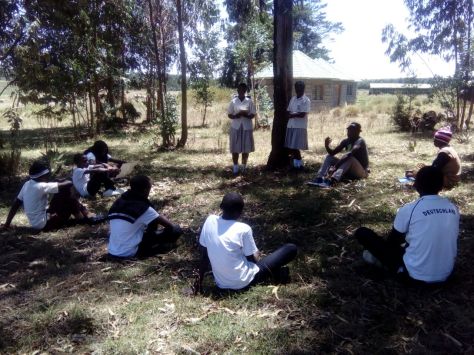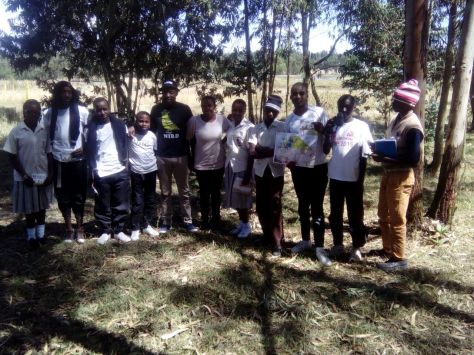
Sharpe’s longclaw. Copyright: Neil Bowman
First allow me to express my sincere gratitude to Nyika Silika for listing this blog among top environmental content providers in Kenya. Humbled to note that there is a group of beautiful souls dedicating their creativity to conservation. May the list grow to fill the empty spaces left by extinct species on the earth surface, in pursuit for a better world. Get the full list here: https://goo.gl/HFebsf
Well, in life you have to choose a struggle, a temporary or lifetime encounter that shapes your lifeline. In most cases, your struggle develops into that one hell of a thing that just can’t let you be. From being the only person awake at 3:30 AM to the only one who is busy on your laptop screen on a Saturday evening when everyone else is either drunk, in a movie theater, betting, or breaking up with their loved ones. Have you ever thought of a man whose only struggle in life is conserving a single species of a bird?
Last weekend we paid a courtesy visit to this awesome group of dedicated, young, and energetic conservationists. The group had invited us, through the Nature Kenya Youth Committee, to educate high school students on climate change.

Well, I have received many requests in my life, but this was the noblest and humbling one. Sitting down with over 100 school children to discuss climate change is the most fulfilling experience one can ever have. It feels like passing the mantle of conservation of our lovely planet from one generation to another.

It could be for the realization of the fact that if nothing is done, the population of the Sharpe’s longclaw with soon reach its lowest which may have devastating effects including extinction of the species from the earth surface, that the friends of Kinangop Plateau were formed in 1996.

Many of you are aware of endemic bird species. In simple terms, these are birds whose existence is defined within a typical range. In simpler words, endemic birds exist only in certain habitats and nowhere else in the world. That is the life of a Sharpe’s Longclaw. A bird whose name was given in recognition of the famous ornithologist, Richard Sharpe. Less than 15,000 species of these birds remain in the grasslands of Kenya’s Kinangop Plateau, some parts of Mau Narok, and Uasin Gishu. However, Kinangop remains the sole safe haven for this beautiful species. In the language of the mountain, the bird is known as “Agathon ka werũ-in”, which loosely translates to “a weaver-like bird which exists only in the grasslands”
Grasslands play a vital role in the existence of the Sharpe’s longclaw. For instance, the bird builds its nest on the grass’ tussocks. Besides, insects found in the extensive grasslands such as beetles provide sustainable meals for the bird. However, unlike many other bird species, the co-existence of this bird species with human beings has always been on the balance, with the feathered friend often being on losing end. Farmers are not comfortable with tussock grasslands which are a haven for the bird since the grass is not palatable for livestock use. As a result, farmers often uproot the grass to grown alternative species that can sustain their livestock. Also, alternative farming methods such as crop farming demand the clearing the grasslands, leaving the endemic species with nowhere to call home. These have been the contributing factors to the dwindling population of the bird’s population.
Friends of Kinangop Plateau have excellent camping facilities that have been constructed to perfectly blend with nature. Besides, through assistance from other stakeholders, including Nature Kenya, the group has acquired about 200 acres of land, put under grasslands for the conservation of the endemic Sharpe’s longclaw. In the process, over 100 other bird species, a number of reptiles, mammals, and plant species are sustainably protected. I can’t leave this here. The station overlooks the beautiful Aberdare Hills, with all the three peaks perfectly protruding! I choose to celebrate the struggle of Friends of Kinangop Plateau.
A trip to the Kinangop Plateau is the perfect way to complement Kenya and to appreciate efforts put in conserving species of Global Importance. Book your customized trip today with Wild World Expeditions (https://goo.gl/e8zwjW) and experience this Important Bird Area (IBA), first hand.

Thanks very much Kelvin for writing this, it good to hear you apretiated the work done by friend of Kinangop plateau, feel free to visit again and see more. Thanks.
LikeLiked by 2 people
Most welcome and keep doing the good course.
LikeLike
Wonderful guys keep up good work,i would loved to be with you. The kikuyu name for the sherps should be Gathonjo kaweru
LikeLiked by 1 person
Hello Zachary, thank you. What does Gathonjo kaweru mean?
LikeLike
Gathojo is weaverbird in Kikuyu. Weru-in means fields. Gothojo ka weru-ini is the weaver like bird of the fields. Sharpe’s Longclaw is also known as Kariithi, which means shephered. In many cases the Sharpe’s longclaw is seen following livestock while grazing. The livestock frushes the insects and the Longclaw feeds on them.
LikeLiked by 2 people
Wow, how insightful! A million thanks. The symbiotic relationship between livestock and the longclaw is amazing.
LikeLike